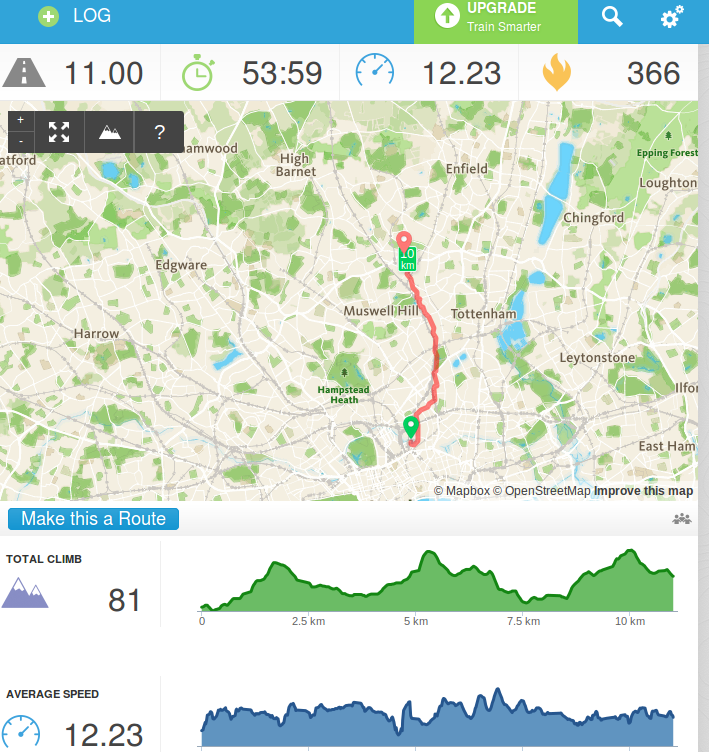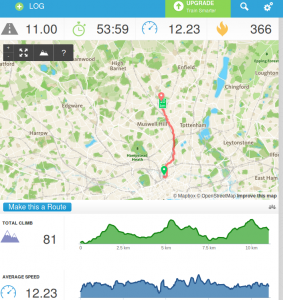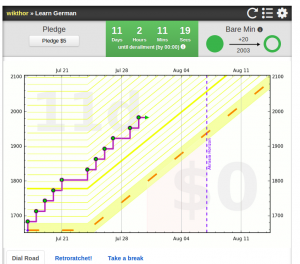There’s always room for another learning gadget here on this blog – it’s one of my hobbies to discover new learning technology. Today I’m trying to write about the big picture: how does “personal informatics” (or the Quantified Self movement) help you learn, in general?
What is Quantified Self?
The term is used (interchangeably with “personal informatics” to describe a movement whose goal is to bring computers and data into your daily life, to measure how you feel, how you perform and what you do. This started the moment someone attached the first heart-rate sensor to a patient. Nowadays, it’s evolved into much more portable, wearable and inter-connected devices.
So how could all these sensors, trackers and measuring tools help you in your daily life? How can you use the quantified self to learn and function better?
Here are three ideas, give me a shout on Facebook or Twitter if you have more 🙂
Measure something to improve it
An app called Runkeeper tracks my daily commute. It’s telling me how fast I cycle, and shows me the route I took (using my smartphone and its GPS).
The first few times I did it, it was just for fun. But after those few rides, I started noticing a few things about my route and my speed. So I started googling, reading and learning. You see, I know almost nothing about cycling.
The first thing I learned was about correct gear shifting – this helped me to stop my bike from disintegrating 🙂 But it also improved my speed a bit.
The second thing was changing the route. I replaced a few long and winding roads with straight and wide ones, to save time and effort.
Finally, I noticed that I cycle faster without my waterproof jacket on. This made sense the moment I read about air drag and aerodynamics – and how little changes in my posture can improve it.
All this learning because of a Runkeeper graph.
Automate accountability
The second screen you can see here comes from Beeminder – and it shows my German learning goal. Beeminder connects with Duolingo and automatically tracks the progress I made each day (Duolingo awards XP points for every session, so that’s straightforward). If I’m learning, then I’m earning the XP points I pledged – and my progress graph stays above the “yellow brick road” you can see on the picture. If I’m slacking, I fall below the road. And (this is the hard part) every time I’m below it for long, I pay up – a small amount is taken from my account.
There are no ifs, no buts (although you can schedule breaks or just cancel the goal altogether). Beeminder featured on this blog before. I didn’t think I’d learn quite as much with its help, though.
I learned that financial motivation gives me enough short-term kicks to move me towards my long-term ideas.
I learned the right amount of commitment per day (as you see, it’s probably safe to raise my pledge on German, as I could do more and still stay safe).
And I also learned the good and bad days for my goals (I’m tracking German and mid-week is awful for it, although I’m also tracking my writing progress, and weekends are usually when I struggle with that).
Adaptive learning
Here, we’re talking about a technology that can change your learning program to help you learn what you need, when you need. It’s still early stages, but some services are already beginning to appear (have you got your Knewton beta yet?)
The first two stages – measuring something and becoming accountable for what you learn – are brought together in adaptive learning approaches. The responsibility for learning the next thing on your way becomes shared between you and the machine. Basically, data helps computers decide what you should learn next, how long for, and when.
It sounds scary and doesn’t always agree with everyone. Education companies are now trying hard to understand adaptive learning, or ignore it (or both). For your personal projects, it’s important to know that your tech gadgets can soon get really good at guessing what you’re up to when you learn (hey, as if Google Now didn’t do this already.)
The missing part: Qualified Self
All three steps above are about quantities. None of them should be about qualifying you automatically.
You cycled 12 km. That’s 1 km more than yesterday. Sounds good? Actually, it’s not – I’m trying to get to work on time, so taking a longer route is bad from my point of view.
You missed two days of German in a row. Should the computer send an angry email? Or was it because you were actually doing something more meaningful offline, and felt super good about this?
Thankfully, the responsibility for deciding how you feel with what you learn is still yours. Giving that away to computers, every time, means trivializing a part of what learning and discovery means to people.
Wiktor (Vic) Kostrzewski (MA, DELTA) is an author, translator, editor and project manage based in London. When he works, he thinks about languages, education, books, EdTech and teachers. When he doesn’t work, he probably trains for his next triathlon or drinks his next coffee.
BRAVE Learning (formerly known as 16 Kinds) is a lifelong learning and productivity blog. If you enjoy these posts, please check out one of my books and courses.
My recent publications, and my archive, is now all available on my new project: PUNK LEARNING. Hope to see you there!



